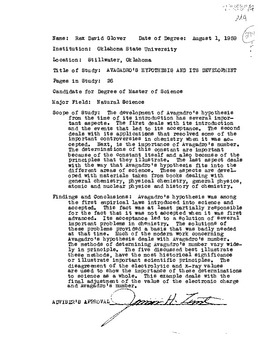| dc.contributor.advisor | Zant, James H. | |
| dc.contributor.author | Glover, Rex David | |
| dc.date.accessioned | 2016-03-03T20:09:12Z | |
| dc.date.available | 2016-03-03T20:09:12Z | |
| dc.date.issued | 1959-08 | |
| dc.identifier.uri | https://hdl.handle.net/11244/32171 | |
| dc.description.abstract | Scope of Study: The development of Avagadro's hypothesis from the time of its introduction has several important aspects. The first deals with its introduction and the events that led to its acceptance. The second deals with its applications that resolved some of the important controversies in chemistry when it was accepted. Next, is the importance of Avagadro's number. The determinations of this constant are important because of the constant itself and also because of the principles that they illustrate. The last aspect deals with the way that Avagadro's hypothesis fits into the different areas of science. These aspects are developed with materials taken from books dealing with general chemistry, physical chemistry, general physics, atomic and nuclear physics and history of chemistry. | |
| dc.description.abstract | Findings and Conclusions: Avagadro's hypothesis was among the first empirical laws introduced into science and accepted. This fact was at least partially responsible for the fact that it was not accepted when it was first advanced. Its acceptance led to a solution of several important problems in chemistry. The solutions of these problems provided a basis that was badly needed at that time. Much of the modern work concerning Avagadro's hypothesis deals with Avagadro's number. The methods of determining Avagadro's number vary widely in principle. The five discussed best illustrate these methods, have the most historical significance or illustrate important scientific principles. The disagreement of the electrolytic and x-ray values are used to show the importance of these determinations to science as a whole. This example deals with the final adjustment of the value of the electronic charge and Avagadro's number. | |
| dc.format | application/pdf | |
| dc.language | en_US | |
| dc.rights | Copyright is held by the author who has granted the Oklahoma State University Library the non-exclusive right to share this material in its institutional repository. Contact Digital Library Services at lib-dls@okstate.edu or 405-744-9161 for the permission policy on the use, reproduction or distribution of this material. | |
| dc.title | Avagadro's hypothesis and its development | |
| dc.contributor.committeeMember | Durbin, Frank M. | |
| osu.filename | Thesis-1959R-G566a.pdf | |
| osu.accesstype | Open Access | |
| dc.type.genre | Master's Report | |
| dc.type.material | Text | |
| thesis.degree.discipline | Natural Science | |
| thesis.degree.grantor | Oklahoma State University | |
